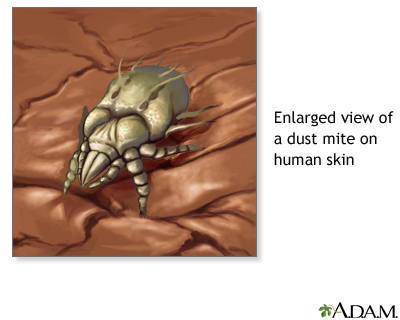| Dust mite allergy |
Dust mite allergy is an allergy to a microscopic organism that lives in the dust that is found in all dwellings and workplaces. Dust mites are perhaps the most common cause of perennial allergic rhinitis. Dust mite allergy usually produces symptoms similar to pollen allergy and also can produce symptoms of asthma.

What is house dust?
Rather than a single substance, so-called house dust is a varied mixture of potentially allergenic materials. It may contain fibers from different types of fabrics; cotton lint, feathers, and other stuffing materials; dander from cats, dogs, and other animals; bacteria; mold and fungus spores (especially in damp areas); food particles; bits of plants and insects; and other allergens peculiar to an individual home.
House dust also contains microscopic mites. These mites, which live in bedding, upholstered furniture, and carpets, thrive in summer and die in winter. In a warm, humid house, however, they continue to thrive even in the coldest months. The particles seen floating in a shaft of sunlight include dead dust mites and their waste-products. These waste-products, which are proteins, actually provoke the allergic reaction.
Waste products of cockroaches are also an important cause of allergy symptoms from household allergens, particularly in some urban areas of the United States.
 |
|
Created by the National Institute of Allergy and Infectious Diseases. Illustration copyright A.D.A.M., Inc.
Reviewed By: Allen J. Blaivas, DO, Clinical Assistant Professor of Medicine UMDNJ-NJMS, Attending Physician in the Division of Pulmonary, Critical Care, and Sleep Medicine, Department of Veteran Affairs, VA New Jersey Health Care System, East Orange, NJ. Review provided by VeriMed Healthcare Network. Previoulsy reviewed by David A. Kaufman, MD, Section Chief, Pulmonary, Critical Care & Sleep Medicine, Bridgeport Hospital-Yale New Haven Health System, and Assistant Clinical Professor, Yale University School of Medicine, New Haven, CT. Review provided by VeriMed Healthcare Network. (6/1/2010)
